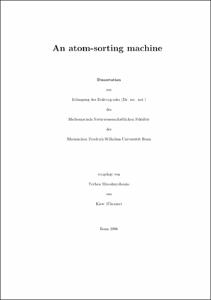An atom-sorting machine

An atom-sorting machine

| dc.contributor.advisor | Meschede, Dieter | |
| dc.contributor.author | Miroshnychenko, Yevhen | |
| dc.date.accessioned | 2020-04-08T23:55:51Z | |
| dc.date.available | 2020-04-08T23:55:51Z | |
| dc.date.issued | 2006 | |
| dc.identifier.uri | https://hdl.handle.net/20.500.11811/2661 | |
| dc.description.abstract | In this thesis I present the realization of a technique for building strings of neutral atoms stored in a standing wave optical dipole trap with any desired interatomic separations atom by atom. As the first application of this technique I demonstrate the preparation of equidistant strings of atoms. Further, I demonstrate that this technique allows us to insert two atoms into a single potential well of a standing wave dipole trap and to deterministically induce light induced collisions between these atoms. The first part of this thesis (Chapters 2 and 3) is devoted to the presentation of tools for trapping and detecting single atoms. A magneto-optical trap is our source of a desired small number of cold atoms. Strings of atoms are stored in a standing wave optical dipole trap. All spatial manipulations with the atoms are carried out with two dipole traps. An intensified CCD camera in combination with molasses cooling allows us to nondestructively observe and determine the positions of the atoms. In the second part (Chapter 4) I describe the realization of the spatial manipulation of the atoms. I demonstrate the creation of strings of up to seven atoms by rearranging initially irregularly spaced atoms. The rearrangement is carried out by extracting atoms out of the initial string and by reinserting them back at predetermined positions using a second standing wave dipole trap operated as optical tweezers. Using this method, the distance between simultaneously trapped atoms can be actively controlled with a precision of 0.78 λ m rms and a success rate of 98 %. This precision corresponds to only 3-4 potential wells of the standing wave trap. Further, I experimentally demonstrate that our reinsertion technique is compatible with the insertion of an atom into the potential of the standing wave already occupied by another atom. We can induce inelastic interaction between these atoms by illuminating them with an optical molasses. The detected success rate of the insertion of one atom into the potential well occupied by the ther atom is 16 (+4/-3) %, which is limited by the precision of insertion with our optical tweezers. Furthermore, I present analytical models of insertion and extraction processes which allows to identify the main mechanisms limiting the performance of our tweezers, e. g., precision and efficiency. Finally, I discuss the possibility to apply of our rearrangement technique to larger number of atoms. | en |
| dc.language.iso | eng | |
| dc.rights | In Copyright | |
| dc.rights.uri | http://rightsstatements.org/vocab/InC/1.0/ | |
| dc.subject | Atomphysik | |
| dc.subject | Laserpinzette | |
| dc.subject | Falle | |
| dc.subject | Atomfalle | |
| dc.subject | Neutralatom | |
| dc.subject | Caesium | |
| dc.subject | Dipole trap | |
| dc.subject | optical tweezers | |
| dc.subject | laser cooling | |
| dc.subject.ddc | 530 Physik | |
| dc.title | An atom-sorting machine | |
| dc.type | Dissertation oder Habilitation | |
| dc.publisher.name | Universitäts- und Landesbibliothek Bonn | |
| dc.publisher.location | Bonn | |
| dc.rights.accessRights | openAccess | |
| dc.identifier.urn | https://nbn-resolving.org/urn:nbn:de:hbz:5N-08430 | |
| ulbbn.pubtype | Erstveröffentlichung | |
| ulbbnediss.affiliation.name | Rheinische Friedrich-Wilhelms-Universität Bonn | |
| ulbbnediss.affiliation.location | Bonn | |
| ulbbnediss.thesis.level | Dissertation | |
| ulbbnediss.dissID | 843 | |
| ulbbnediss.date.accepted | 16.08.2006 | |
| ulbbnediss.fakultaet | Mathematisch-Naturwissenschaftliche Fakultät | |
| dc.contributor.coReferee | Weitz, Martin |
Files in this item
This item appears in the following Collection(s)
-
E-Dissertationen (4442)




